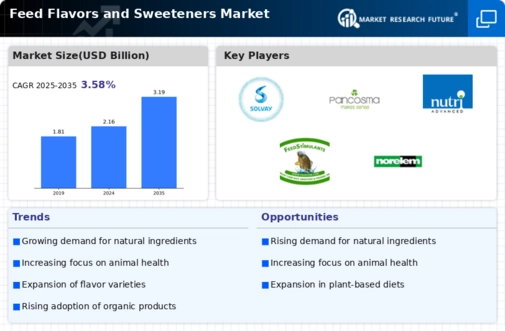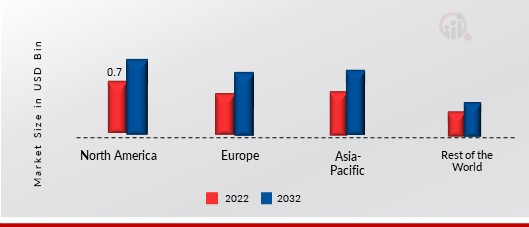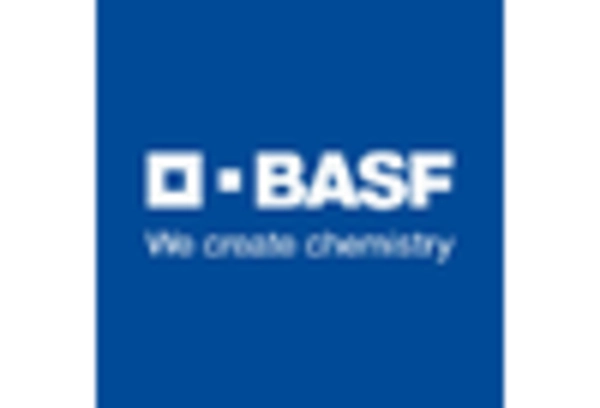-
Executive Summary
-
Scope of the Report
-
Market Definition
-
Scope of the Study
- Research Objectives
- Assumptions & Limitations
-
Market Structure
-
Market Research Methodology
-
Research Process
-
Secondary Research
-
Primary Research
-
Forecast Model
-
Market Landscape
-
Supply Chain Analysis
- Raw Material Suppliers
- Manufacturers/Producers
- Distributors/Retailers/Wholesalers/E-Commerce
- End Users
-
Porter’s Five Forces Analysis
- Threat of New Entrants
- Bargaining Power of Buyers
- Bargaining Power of Suppliers
- Threat of Substitutes
- Internal Rivalry
-
Market Dynamics of the Global Feed Flavors & Sweeteners Market
-
Introduction
-
Drivers
-
Restraints
-
Opportunities
-
Challenges
-
Global Feed Flavors & Sweeteners Market, by Type
-
Introduction
-
Flavors
- Market Estimates & Forecast, 2023–2032
- Market Estimates & Forecast, by Region, 2023–2032
- Sweet
- Savory
- Others
-
Sweeteners
- Market Estimates & Forecast, 2023–2032
- Market Estimates & Forecast, by Region, 2023–2032
- Saccharine
- Glycyrrhizin
- Neohesperidine Dihydrochalcone
- Others
-
Global Feed Flavors & Sweeteners Market, by Form
-
Introduction
-
Dry
- Market Estimates & Forecast, 2023–2032
- Market Estimates & Forecast, by Region, 2023–2032
-
Liquid
- Market Estimates & Forecast, 2023–2032
- Market Estimates & Forecast, by Region, 2023–2032
-
Global Feed Flavors & Sweeteners Market, by Source
-
Introduction
-
Natural
- Market Estimates & Forecast, 2023–2032
- Market Estimates & Forecast, by Region, 2023–2032
-
Synthetic
- Market Estimates & Forecast, 2023–2032
- Market Estimates & Forecast, by Region, 2023–2032
-
Global Feed Flavors & Sweeteners Market, by Livestock
-
Introduction
-
Ruminants
- Market Estimates & Forecast, 2023–2032
- Market Estimates & Forecast, by Region, 2023–2032
-
Swine
- Market Estimates & Forecast, 2023–2032
- Market Estimates & Forecast, by Region, 2023–2032
-
Pet
- Market Estimates & Forecast, 2023–2032
- Market Estimates & Forecast, by Region, 2023–2032
-
Others
- Market Estimates & Forecast, 2023–2032
- Market Estimates & Forecast, by Region, 2023–2032
-
Global Feed Flavors & Sweeteners Market, by Region
-
Introduction
-
North America
- Market Estimates & Forecast, 2023–2032
- Market Estimates & Forecast, by Type, 2023–2032
- Market Estimates & Forecast, by Form, 2023–2032
- Market Estimates & Forecast, by Source, 2023–2032
- Market Estimates & Forecast, by Livestock, 2023–2032
- US
- Canada
- Mexico
-
Europe
- Market Estimates & Forecast, 2023–2032
- Market Estimates & Forecast, by Type, 2023–2032
- Market Estimates & Forecast, by Form, 2023–2032
- Market Estimates & Forecast, by Source, 2023–2032
- Market Estimates & Forecast, by Livestock, 2023–2032
- Germany
- France
- Italy
- Spain
- UK
- Rest of Europe
-
Asia-Pacific
- Market Estimates & Forecast, 2023–2032
- Market Estimates & Forecast, by Type, 2023–2032
- Market Estimates & Forecast, by Form, 2023–2032
- Market Estimates & Forecast, by Source, 2023–2032
- Market Estimates & Forecast, by Livestock, 2023–2032
- China
- India
- Japan
- Australia & New Zealand
- Rest of Asia-Pacific
-
Rest of the World (RoW)
- Market Estimates & Forecast, 2023–2032
- Market Estimates & Forecast, by Type, 2023–2032
- Market Estimates & Forecast, by Form, 2023–2032
- Market Estimates & Forecast, by Source, 2023–2032
- Market Estimates & Forecast, by Livestock, 2023–2032
- South America
- The Middle East
- Africa
-
Company Landscape
-
Introduction
-
Market Strategy
-
Key Development Analysis
-
(Expansions/Mergers and Acquisitions/Joint Ventures/New Product Developments/Agreements/Investments)
-
Company Profiles
-
Grupo Ferrer Internacional S.A.
- Company Overview
- Financial Updates
- Product/Business Segment Overview
- Strategy
- Key Developments
- SWOT Analysis
-
Solvay
- Company Overview
- Financial Updates
- Product/Business Segment Overview
- Strategy
- Key Developments
- SWOT Analysis
-
Nutriad
- Company Overview
- Financial Updates
- Product/Business Segment Overview
- Strategy
- Key Developments
- SWOT Analysis
-
Pancosma
- Company Overview
- Financial Updates
- Product/Business Segment Overview
- Strategy
- Key Developments
- SWOT Analysis
-
Alltech
- Company Overview
- Financial Updates
- Product/Business Segment Overview
- Strategy
- Key Developments
- SWOT Analysis
-
FeedStimulants
- Company Overview
- Financial Updates
- Product/Business Segment Overview
- Strategy
- Key Developments
- SWOT Analysis
-
BIOMIN Holding
- Company Overview
- Financial Updates
- Product/Business Segment Overview
- Strategy
- Key Developments
- SWOT Analysis
-
DuPont
- Company Overview
- Financial Updates
- Product/Business Segment Overview
- Strategy
- Key Developments
- SWOT Analysis
-
Norel
- Company Overview
- Financial Updates
- Product/Business Segment Overview
- Strategy
- Key Developments
- SWOT Analysis
-
Prinova Group LLC
- Company Overview
- Financial Updates
- Product/Business Segment Overview
- Strategy
- Key Developments
- SWOT Analysis
-
Agri-Flavors
- Company Overview
- Financial Updates
- Product/Business Segment Overview
- Strategy
- Key Developments
- SWOT Analysis
-
Origination O2D
- Company Overview
- Financial Updates
- Product/Business Segment Overview
- Strategy
- Key Developments
- SWOT Analysis
-
Kerry Group
- Company Overview
- Financial Updates
- Product/Business Segment Overview
- Strategy
- Key Developments
- SWOT Analysis
-
Pestell Minerals & Ingredients
- Company Overview
- Financial Updates
- Product/Business Segment Overview
- Strategy
- Key Developments
- SWOT Analysis
-
Kemin Industries, Inc.
- Company Overview
- Financial Updates
- Product/Business Segment Overview
- Strategy
- Key Developments
- SWOT Analysis
-
Conclusion
-
-
LIST OF TABLES
-
Global Feed Flavors & Sweeteners, by Region, 2023–2032 (USD Million)
-
Global Feed Flavors & Sweeteners, by Type, 2023–2032 (USD Million)
-
Global Feed Flavors & Sweeteners, by Form,2023–2032 (USD Million)
-
Global Feed Flavors & Sweeteners, by Source, 2023–2032 (USD Million)
-
Global Feed Flavors & Sweeteners, by Livestock, 2023–2032 (USD Million)
-
North America: Feed Flavors & Sweeteners, by Country, 2023–2032 (USD Million)
-
North America: Feed Flavors & Sweeteners, by Type, 2023–2032 (USD Million)
-
North America: Feed Flavors & Sweeteners, by Form,2023–2032 (USD Million)
-
North America: Feed Flavors & Sweeteners, by Source, 2023–2032 (USD Million)
-
North America: Feed Flavors & Sweeteners, by Livestock, 2023–2032 (USD Million)
-
US: Feed Flavors & Sweeteners, by Type, 2023–2032 (USD Million)
-
US: Feed Flavors & Sweeteners, by Form,2023–2032 (USD Million)
-
US: Feed Flavors & Sweeteners, by Source, 2023–2032 (USD Million)
-
US: Feed Flavors & Sweeteners, by Livestock, 2023–2032 (USD Million)
-
Canada: Feed Flavors & Sweeteners, by Type, 2023–2032 (USD Million)
-
Canada: Feed Flavors & Sweeteners, by Form,2023–2032 (USD Million)
-
Canada: Feed Flavors & Sweeteners, by Source, 2023–2032 (USD Million)
-
Canada: Feed Flavors & Sweeteners, by Livestock, 2023–2032 (USD Million)
-
Mexico: Feed Flavors & Sweeteners, by Type, 2023–2032 (USD Million)
-
Mexico: Feed Flavors & Sweeteners, by Form,2023–2032 (USD Million)
-
Mexico: Feed Flavors & Sweeteners, by Source, 2023–2032 (USD Million)
-
Mexico: Feed Flavors & Sweeteners, by Livestock, 2023–2032 (USD Million)
-
Europe: Feed Flavors & Sweeteners, by Country, 2023–2032 (USD Million)
-
Europe: Feed Flavors & Sweeteners, by Type, 2023–2032 (USD Million)
-
Europe: Feed Flavors & Sweeteners, by Form,2023–2032 (USD Million)
-
Europe: Feed Flavors & Sweeteners, by Source, 2023–2032 (USD Million)
-
Europe: Feed Flavors & Sweeteners, by Livestock, 2023–2032 (USD Million)
-
Germany: Feed Flavors & Sweeteners, by Type, 2023–2032 (USD Million)
-
Germany: Feed Flavors & Sweeteners, by Form,2023–2032 (USD Million)
-
Germany: Feed Flavors & Sweeteners, by Source, 2023–2032 (USD Million)
-
Germany: Feed Flavors & Sweeteners, by Livestock, 2023–2032 (USD Million)
-
France: Feed Flavors & Sweeteners, by Type, 2023–2032 (USD Million)
-
France: Feed Flavors & Sweeteners, by Form,2023–2032 (USD Million)
-
France: Feed Flavors & Sweeteners, by Source, 2023–2032 (USD Million)
-
France: Feed Flavors & Sweeteners, by Livestock, 2023–2032 (USD Million)
-
Italy: Feed Flavors & Sweeteners, by Type, 2023–2032 (USD Million)
-
Italy: Feed Flavors & Sweeteners, by Form,2023–2032 (USD Million)
-
Italy: Feed Flavors & Sweeteners, by Source, 2023–2032 (USD Million)
-
Italy: Feed Flavors & Sweeteners, by Livestock, 2023–2032 (USD Million)
-
Spain: Feed Flavors & Sweeteners, by Type, 2023–2032 (USD Million)
-
Spain: Feed Flavors & Sweeteners, by Form,2023–2032 (USD Million)
-
Spain: Feed Flavors & Sweeteners, by Source, 2023–2032 (USD Million)
-
Spain: Feed Flavors & Sweeteners, by Livestock, 2023–2032 (USD Million)
-
UK: Feed Flavors & Sweeteners, by Type, 2023–2032 (USD Million)
-
UK: Feed Flavors & Sweeteners, by Form,2023–2032 (USD Million)
-
UK: Feed Flavors & Sweeteners, by Source, 2023–2032 (USD Million)
-
UK: Feed Flavors & Sweeteners, by Livestock, 2023–2032 (USD Million)
-
Rest of Europe: Feed Flavors & Sweeteners, by Type, 2023–2032 (USD Million)
-
Rest of Europe: Feed Flavors & Sweeteners, by Form,2023–2032 (USD Million)
-
Rest of Europe: Feed Flavors & Sweeteners, by Source, 2023–2032 (USD Million)
-
Rest of Europe: Feed Flavors & Sweeteners, by Livestock, 2023–2032 (USD Million)
-
Asia-Pacific: Feed Flavors & Sweeteners, by Country, 2023–2032 (USD Million)
-
Asia-Pacific: Feed Flavors & Sweeteners, by Type, 2023–2032 (USD Million)
-
Asia-Pacific: Feed Flavors & Sweeteners, by Form,2023–2032 (USD Million)
-
Asia-Pacific: Feed Flavors & Sweeteners, by Source, 2023–2032 (USD Million)
-
Asia-Pacific: Feed Flavors & Sweeteners, by Livestock, 2023–2032 (USD Million)
-
China: Feed Flavors & Sweeteners, by Type, 2023–2032 (USD Million)
-
China: Feed Flavors & Sweeteners, by Form,2023–2032 (USD Million)
-
China: Feed Flavors & Sweeteners, by Source, 2023–2032 (USD Million)
-
China: Feed Flavors & Sweeteners, by Livestock, 2023–2032 (USD Million)
-
India: Feed Flavors & Sweeteners, by Type, 2023–2032 (USD Million)
-
India: Feed Flavors & Sweeteners, by Form,2023–2032 (USD Million)
-
India: Feed Flavors & Sweeteners, by Source, 2023–2032 (USD Million)
-
India: Feed Flavors & Sweeteners, by Livestock, 2023–2032 (USD Million)
-
Japan: Feed Flavors & Sweeteners, by Type, 2023–2032 (USD Million)
-
Japan: Feed Flavors & Sweeteners, by Form,2023–2032 (USD Million)
-
Japan: Feed Flavors & Sweeteners, by Source, 2023–2032 (USD Million)
-
Japan: Feed Flavors & Sweeteners, by Livestock, 2023–2032 (USD Million)
-
Australia & New Zealand: Feed Flavors & Sweeteners, by Type, 2023–2032 (USD Million)
-
Australia & New Zealand: Feed Flavors & Sweeteners, by Form,2023–2032 (USD Million)
-
Australia & New Zealand: Feed Flavors & Sweeteners, by Source, 2023–2032 (USD Million)
-
Australia & New Zealand: Feed Flavors & Sweeteners, by Livestock, 2023–2032 (USD Million)
-
Rest of Asia-Pacific: Feed Flavors & Sweeteners, by Type, 2023–2032 (USD Million)
-
Rest of Asia-Pacific: Feed Flavors & Sweeteners, by Form,2023–2032 (USD Million)
-
Rest of Asia-Pacific: Feed Flavors & Sweeteners, by Source, 2023–2032 (USD Million)
-
Rest of Asia-Pacific: Feed Flavors & Sweeteners, by Livestock, 2023–2032 (USD Million)
-
Rest of the World (RoW): Feed Flavors & Sweeteners, by Country, 2023–2032 (USD Million)
-
Rest of the World (RoW): Feed Flavors & Sweeteners, by Type, 2023–2032 (USD Million)
-
Rest of the World (RoW): Feed Flavors & Sweeteners, by Form,2023–2032 (USD Million)
-
Rest of the World (RoW): Feed Flavors & Sweeteners, by Source, 2023–2032 (USD Million)
-
Rest of the World (RoW): Feed Flavors & Sweeteners, by Livestock, 2023–2032 (USD Million)
-
South America: Feed Flavors & Sweeteners, by Type, 2023–2032 (USD Million)
-
South America: Feed Flavors & Sweeteners, by Form,2023–2032 (USD Million)
-
South America: Feed Flavors & Sweeteners, by Source, 2023–2032 (USD Million)
-
South America: Feed Flavors & Sweeteners, by Livestock, 2023–2032 (USD Million)
-
Middle East: Feed Flavors & Sweeteners, by Type, 2023–2032 (USD Million)
-
Middle East: Feed Flavors & Sweeteners, by Form,2023–2032 (USD Million)
-
Middle East: Feed Flavors & Sweeteners, by Source, 2023–2032 (USD Million)
-
Middle East: Feed Flavors & Sweeteners, by Livestock, 2023–2032 (USD Million)
-
Africa: Feed Flavors & Sweeteners, by Type, 2023–2032 (USD Million)
-
Africa: Feed Flavors & Sweeteners, by Form,2023–2032 (USD Million)
-
Africa: Feed Flavors & Sweeteners, by Source, 2023–2032 (USD Million)
-
Africa: Feed Flavors & Sweeteners, by Livestock, 2023–2032 (USD Million)
-
-
LIST OF FIGURES
-
Global Feed Flavors & Sweeteners Market Segmentation
-
Forecast Research Methodology
-
Five Forces Analysis of Global Feed Flavors & Sweeteners Market
-
Value Chain of Global Feed Flavors & Sweeteners Market
-
Share of Global Feed Flavors & Sweeteners Market in 2023, by Country (%)
-
Global Feed Flavors & Sweeteners Market, by Region, 2023–2032,
-
Global Feed Flavors & Sweeteners Market Size, by Type, 2023
-
Share of Global Feed Flavors & Sweeteners Market, by Type, 2023–2032 (%)
-
Global Feed Flavors & Sweeteners Market Size, by Source, 2023
-
Share of Global Feed Flavors & Sweeteners Market, by Source, 2023–2032 (%)
-
Global Feed Flavors & Sweeteners Market Size, by Form, 2023
-
Share of Global Feed Flavors & Sweeteners Market, by Form, 2023–2032 (%)
-
Global Feed Flavors & Sweeteners Market Size, by Livestock, 2023
-
Share of Global Feed Flavors & Sweeteners Market, by Livestock, 2023–2032 (%)










Leave a Comment